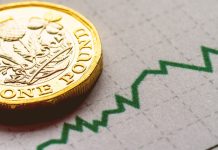- Indian Rupee (INR) holds steady after gains last week
- India’s GDP growth is expected to slow in Oct-Dec quarter
- US Dollar (USD) falls, extending losses from last week
- The US economic calendar ramps up tomorrow
The US Dollar Indian Rupee (USD/INR) exchange rate is rising modestly after losses last week. The pair fell -0.19% in the previous week, settling on Friday at 82.86. At 14:00 UTC, USD/INR trades +0.01% at 82.87 and trades in a range of 82.86 to 82.968.
The Indian rupee is holding steady against a weaker USD despite reports that economic growth may have slowed to 6.6% year on year in the October to December quarter as government spending slowed and amid muted growth in the agricultural sector.
Manufacturing, which contributes around 17% to India’s GDP, grew at its fastest pace in the July to September quarter since early in the 2021/22 fiscal year.
India. Asia’s third-lowest economy grew 7.8% and 7.6% in the first two quarters of the current fiscal year, which ends next month.
The US Dollar is rising against the Rupee but falling against its major peers. The US Dollar Index, which measures the greenback versus a basket of major currencies, trades at -0.13% at the time of writing at 103.80, after losses last week.
The USD fell last week amid an upbeat market mood after stronger-than-expected results from Nvidia fueled AI hype, and the risk on mood drove safe haven outflows.
The US dollar booked its first weekly decline since the start of the year despite encouraging data such as stronger-than-expected jobless claims and Federal Reserve commentary pushing back on interest rate cuts.
Today, the USD started the week off on the back foot as investors look ahead to a busy week on the economic calendar. Tomorrow sees the release of US durable goods orders and GDP data on Wednesday, and the Federal Reserve’s preferred inflation reading is due on Thursday.
The markets will use the data to assess when the Federal Reserve could start to cut rates. The markets are betting on around 81 basis points of rate cuts by the end of the year. This is about half what was expected at the start of the year. Meanwhile, the market is pricing in the first rate cut in June, roughly in line with the Federal Reserve guidance.





